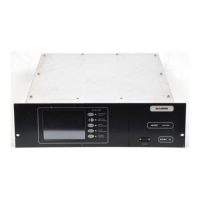transmittertuning procedure in SECTION II, Installation/Initial
turn on, for additional information.
6.31 Other Troubleshooting Techniques
6.31.1 Handling MOSFET’s
Due to the fragile nature of the gate of a MOSFET, special care
intheir handling isrequired.The gate junction may bedestroyed
ifstaticelectricityis allowedtodischargethrough theMOSFET.
For example, a static charge could build up on a person as they
walk across a carpet and discharge across the MOSFET if it is
not protected by antistatic packaging.
NOTE
MOSFET transistors which are in circuit are immune to this
damage.
The MOSFET transistors are shipped in antistatic packaging.
The transistors should remain in this packaging until they are to
be used or tested. Proper precautions should be observed to
ground any potential static charge before handling the MOS-
FETS.
6.31.2
Testing MOSFET’s
The MOSFET’s will have to be removed from the circuit in
order to perform the following test.
Observe the precautions in the paragraph entitled “Handling
MOSFET’S” in this section.
The MOSFET’s used in the DX-25U transmitter may be
checked with an ohmmeter. However, there is a requirement
which restrictsthe use of someohmmeters. If thebattery voltage
is too low (under 3V) or too high (over 20V) the ohmmeter
cannot be used. A battery voltage less than 3V will not give an
operational check of the transistor and a battery voltage greater
than 20V may result in damage to the transistor under test. A
Simpson 260, which uses a 9V battery on the Rx10K scale
works quite well.
This test will show how a MOSFET can be switched “ON” and
“OFF” by charging and discharging the gate of the MOSFET.
Connect the positive lead of the ohmmeter to the drain or case
ofthetransistor.Connectthenegativeleadtosource.Alternately
touch a jumper from gate to source and then from gate to drain.
The ohmmeter should read towards infinity or at least 2 me-
gOhms when the MOSFET is switched “OFF”and lessthan90k
Ohms when the MOSFET is switched “ON.” When doing this
test, lay the MOSFET on a flat surface or hold sides of the case.
The resistance of your finger tips and skin will effect the
readings when you touch the leads.
6.31.3
Finding A Missing Step
It is possible to have a failed PA Module without the Fault LED
being illuminated. It should be possible to see this problem on
the detected audio waveform. If a “Big Step” PA Module is not
operating properly, anerror in the demodulatedaudiowaveform
will be present as seen in Figure 6-1. This kind of error is
apparent only with triangle (linear ramp) tone modulation. If a
PA Module failure is suspected, operate the transmitter at 30
kW at full modulation. Display the demodulated audio output
of a modulation monitor on a dual trace scope. If a big step
amplifier is not working, an error will be noticeable on the
display. To determine which amplifier is at fault, connect the
second channel of the scope to a probe and look at the output of
the Modulation Encoder for each big step until the transition
from 0 to 5VDC occurs at the same point in time as the error on
thewaveform.SeeFigure6-1.
Because there are 58 “Big Steps”, it helps to knowwhere to start
to look on the modulation encoder.A good rule is thatthe higher
the positive peak level where the error occurs, the higher the
step number. A 100% modulated signal at 30 kW is NOT using
allthebigsteps — stepsRF48throughRF58 areonlyONduring
positive peaks. To check these steps, a non-symmetrical audio
waveform should be used in order to modulate the transmitter
with a steady state tone at 125% positive peak without causing
overmodulation, and carrier shift, on the negative peaks.
Figure 6-2 shows a non-symmetrical ramp modulating to 125%
positive peak and only 50% negative peak. An error is also
shown near the top of the positive peak indicating a big step
failure at approximately “Big Step” RF55. The Modulation
Encoder waveform is also shown for that step. Once the step
causing the error is located, the PA Module can be changed. If
substituting the PA Module does not remove the error, then the
problem may exist on the Modulation Encoder.
6.31.4
Using FlexPatch™ for Bypassing a Failed
PA Module
FlexPatch™ is a Harris feature to allow the engineer to patch a
failed RF amplifier from an active step position, such as step
RF6, to a step position that is only used for positive peak
modulation, such as step RF90. Module RF90 will now operate
as module RF6. This patching is done at a “TTL” level basis
and can be done while the transmitter is on the air.
Because approximately 47 RF amplifiers are used to create 50
kW carrier, a failed module in the RF6 position will result in a
power output drop of approximately 2% and a slight THD
increase. The transmitter will operate with no other problems in
this condition. However, FlexPatch™ will allow the transmitter
to resume operation at full power and optimum modulation
clarity with only a slight loss of positive peak capability.
Refer to Figure 6-8 for the following procedure. To use the
FlexPatch™ feature to bypass a failed PA Module:
a. On the Modulation Encoder controlling the failed RF
amplifier,locateand removethegold jumperfor thefailed
RF amplifier to be patched.
b. Locate and remove the gold jumper for step RF90 on
Modulation Encoder A37. Step RF90 is selected because
it would only be ON during the highest positive peaks.
c. Locate and remove one of the FlexPatch™ jumpers and
connect one end to the OUTPUT signal side from where
the jumper plug was removed for the failed amplifier.
DX-25U
6-18 888-2297-002 Rev. R: 11-11-96
WARNING: Disconnect primary power prior to servicing.
